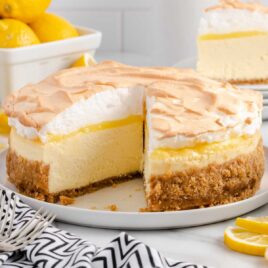Lemon Meringue Cheesecake
Our lemon meringue cheesecake is a creamy, tart, and sweet dessert with a luscious texture that is sure to be the star of the show.
Servings: 12
Calories: 694kcal
Ingredients
Crust
- 2½ cups crushed Nilla wafer cookies, or generic version
- 5 tablespoons granulated sugar
- ½ cup salted sweet cream butter, melted and cooled
Lemon Cheesecake Filling
- 1½ cups granulated sugar
- 3 tablespoons cornstarch
- 32 ounces cream cheese, softened
- ⅔ cup sour cream, room temperature
- 1 tablespoon fresh lemon zest
- 2 tablespoons fresh lemon juice
- 2 teaspoons pure vanilla extract
- 6 large eggs, room temperature
- ¾ cup lemon curd
Meringue
- 4 large egg whites, room temperature
- ¼ teaspoon cream of tartar
- ¼ cup granulated sugar
Instructions
- Preheat the oven to 325°F. Wrap the outside of a 9 x 3 springform pan in 2 oversized pieces of heavy-duty aluminum foil. Be sure to wrap all the way up the sides of the pan. Generously spray the springform pan with nonstick cooking spray. (I also used a round parchment circle to line the bottom of the pan) Set it aside.
- Add the Nilla wafer crumbs and sugar to a medium-sized mixing bowl. Stir to combine.
- Pour the melted butter over the crumb mixture and stir to coat the crumb mixture completely.
- Press the buttered crumb mixture into the bottom of the springform pan and about 1 inch up the sides of the pan. Set it aside.
- Add the granulated sugar and cornstarch to a small mixing bowl. Whisk to combine.
- Using a stand mixer or a large mixing bowl and a handheld mixer on medium-low speed, beat the cream cheese and sour cream just until smooth.
- Add the lemon zest, lemon juice, and vanilla extract. Mix just until combined.
- Add the granulated sugar mixture and continue to mix on medium-low speed for another 1 to 1½ minutes until well incorporated.
- Lower the mixer speed to low. Add the eggs one at a time, mixing well after each egg. Mix just until no yellow streaks remain.
- Pour the cheesecake batter on top of the crust. Gently tap the springform pan to help release any air bubbles.
- Place the foil-wrapped springform pan in an oversized roasting pan. (I use a disposable turkey roasting pan.) Place the roasting pan on the middle rack of the oven.
- Pour boiling water into the roasting until it comes up about 1 inch on the outside of the springform pan.
- Bake for 1 hour and 30 minutes. Turn the oven off and crack the oven door open about 1 to 2 inches. Leave the cheesecake to sit in the oven for 1 hour.
- Remove the cheesecake from the oven and the water bath. Remove the foil and allow the cheesecake to sit on a cooling rack for 1 hour. Do not remove the cheesecake from the springform pan.
- Spoon the lemon curd on top of the cheesecake. Be sure to avoid the edges.
- Preheat the oven to 350°F.
- Using either a stand mixer fitted with the wire whip attachment, or a large mixing bowl and a handheld mixer on high, beat the egg whites and cream of tartar until soft peaks form. Gradually add in the granulated sugar. Continue beating on high until the meringue forms stiff peaks and has a shiny gloss.
- Spread the meringue over the top of the lemon curd. Bake for 12 to 15 minutes or until the meringue is a light golden brown. Chill the cheesecake in the springform pan in the refrigerator for at least 8 hours.
- Remove the cheesecake from the refrigerator. Slowly release the springform pan sides. Use a sturdy spatula to remove the cheesecake from the bottom of the springform pan. Place the cheesecake onto a serving plate or a disposable cake circle. Slice into 12 slices before serving.
Notes
- Always make sure your cream cheese, sour cream, and eggs are at room temperature. This will make blending the cream cheese and sour cream much easier. The longer you have to blend the cream cheese and sour cream means more air in the cheesecake filling.
- Always zest the lemon before juicing.
- Try to keep the mixer speed at or below medium-low speed. Air is not your friend when making cheesecake.
- Oven temperatures vary and may need to be recalibrated periodically to ensure they are accurate. Make sure to keep a close eye on your cheesecake as the suggested baking time approaches.
Nutrition
Calories: 694kcal | Carbohydrates: 67g | Protein: 11g | Fat: 44g | Saturated Fat: 24g | Polyunsaturated Fat: 4g | Monounsaturated Fat: 11g | Trans Fat: 0.4g | Cholesterol: 197mg | Sodium: 491mg | Potassium: 205mg | Fiber: 0.4g | Sugar: 53g | Vitamin A: 1467IU | Vitamin C: 2mg | Calcium: 105mg | Iron: 1mg
